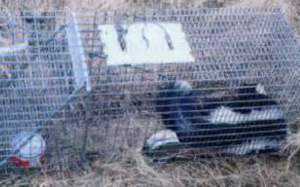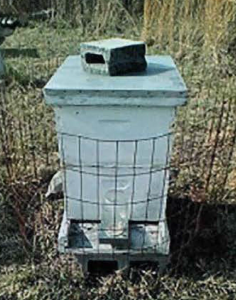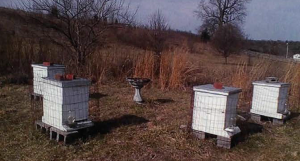By: Barbara Gillette
This article originally appeared in the Summer 2017 issue of BEEKeeping Your First Three Years
Call to Arms
On a bright sunny morning you arrive at the apiary ready to inspect your hives. It is bloom season and the nectar flow is going strong. Your last inspection showed good laying patterns and plenty of bees. But today the bees seem agitated and aggressive. The fronts of your newly painted deep hive bodies look as if someone went at them with a garden trowel. Something black and crunchy is stuck to the bottom of your boot. On closer inspection, the black crunchy thing appears to be full of little yellow and brown bee parts.
Unlikely as it might seem at first, here is a dedicated beekeeper’s chance to shine. Not only do you have a problem to solve. Better yet, this is one of those great opportunities for you to support and help your honey bees. Odds are, your hives are under siege by one of the smaller but most feared North American mammals, the common striped skunk.
RULE #1:
Know the Enemy
 Weighing in at just 3-11 pounds, the striped skunk is found throughout North America. Living predominantly along woodland edges, this animal favors habitat with a water source and, with claws made for digging, it seeks out places to burrow for shelter. Aside from the Great Horned Owl, a raptor with a poor olfactory sense, this common skunk has few enemies. It may feed on mice, frogs, crayfish, eggs and fruit, but insects make up the biggest part of this critter’s diet and honey bees are a favorite flavor.
Weighing in at just 3-11 pounds, the striped skunk is found throughout North America. Living predominantly along woodland edges, this animal favors habitat with a water source and, with claws made for digging, it seeks out places to burrow for shelter. Aside from the Great Horned Owl, a raptor with a poor olfactory sense, this common skunk has few enemies. It may feed on mice, frogs, crayfish, eggs and fruit, but insects make up the biggest part of this critter’s diet and honey bees are a favorite flavor.
Skunks are diurnal. This means they sleep during the day and are most often detected just before dawn and just after dusk. I use the word detected because you know this animal is around by its distinct odor. Skunks do not hibernate but often burrow underground in Winter or when raising young. Live sightings are fairly rare although skunks may be seen in daylight hours in early Winter during their mating season. Females raising kits also hunt during the day to stay in the burrow at night and protect the litter from other nocturnal predators. Where I live in Central Kentucky, sightings begin to occur in February after the female has birthed between 5 and 7 kits. Three years ago in early June we mowed hay on several acres surrounding our small apiary. Our hay man stopped by the house on his way out to share his sighting of an adult skunk and five kits leaving the bee yard. No doubt mama was taking her growing babies out to lunch, teaching them exactly where to go and how to get it.
RULE #2:
Identify the Enemy’s Strengths and Weaknesses
If you think you see a skunk, the stark white markings against the predominantly black fur will leave no doubt in your mind. Pick up your dog and run the other way, fast. The skunk most likely will not run or at least not very fast. It might snap its teeth and stomp its feet. This is a warning. If the threat continues, the skunk. simply lifts its tail, rocks forward into a handstand and shoots a spray of viscous yellow goo up to 15 feet. If you miss the warning signals, instantly you are enveloped in a cloud of the most vile, wretched odor ever to hit your nose. It permeates everything including air, lawn, nearby shrubs and trees, outdoor furniture, your skin, the inside of your nasal passages and your clothes and hair. If you, or more likely your dog, is unlucky enough to get hit with the yellow goo, immediately wash it off with a running hose. Start with the eyes. Skunk spray contains a toxin that can cause temporary blindness in other animals and birds.
Studies show that honey bees do have a developed sense of olfactory. We know that this affects hive communication and the identification of good pollen and nectar sources. Whether or not honey bees can smell skunk, I don’t know. It would certainly help to explain the ill-temper of a hive under siege by one of these stinkers.
Skunks have thick leathery skin covered by heavy fur. These traits protect the animal against multiple stings it might receive when frequenting your hives in search of dinner. Their eyesight is poor and even though their habits are mostly nocturnal they are not deterred by bright light. Although an unexpected stream of water might startle a skunk into departing your bee yard, skunks don’t mind getting wet. Water sources along with beehives are good hunting grounds. Most skunks are not good climbers with the exception of the hog-nosed skunk found in the southwest including west Texas, southern New Mexico and parts of Nevada.
RULE #3:
Study the Enemy’s Strategy
Shortly after dark, the skunk will approach and begin to scratch the front of the deep hive body. Guard bees are alerted and send out the danger pheromone. As the bees race out to dispel the intruder the skunk scoops them up by the pawful, sucks out all the juicy parts and spits a wad of the indigestible crunchy stuff out on the ground. When her kits are old enough to learn to hunt the female skunk leads them straight out to your bee yard for a first hand demonstration. If the litter is five babies plus a mother making repeated trips to your hives, the results can get problematic very quickly. Skunks are not particularly territorial and adults sometimes burrow in groups. It’s easy to see how the problem can multiply. Just so you know, skunk kits develop their scent glands early in life.
RULE #4:
Don’t Underestimate the Enemy
When you consider the problems of mites, other predators such as bears, or the unpredictability of the weather, the common striped skunk may seem like the least of your worries. But don’t get caught in the trap of complacency. Animals choose their habitats based on food, water, and shelter and your honey bees provide an easy food source. It may not appear to adversely affect your colonies at first. Remember that strong colonies are your best resource for success, and consistent predation from skunks can weaken your hives, opening the door to wax moth and hive beetles just for starters. It is not unknown for bees to give up and abscond following repeated and ongoing attacks from skunks. Once a skunk makes a burrow in your neighborhood and successfully raises a litter, it will return year after year until you find a way to say good riddance. Easier said than done.
RULE #5:
Fortify Your Defenses (an ounce of prevention…)
Here in rural Kentucky, we’ve been battling these stinkers for eight years. They’ve raised litter after litter in our next door neighbor’s vacated barn. We’ve offered several solutions. Unfortunately he thinks they are cute and likes to watch them eat from the cat food bowl on his front porch. How to develop good relationships with your neighbors can be a challenge, but this is a different subject in and of itself.
Skunks can be trapped and cat food is excellent bait. But what to do once the skunk is in the trap? I have heard tales of talking softly and carrying a big tarp to throw over the trap before the skunk sprays. Then you’ve got to relocate preferably miles and miles away and get the tarp off and the cage spring released on the other end. Hmmmm. Some companies sell specialized traps for skunks. These can be expensive but may be worth the cost if your problem is ongoing.
If you do manage to trap a skunk, it can be extremely difficult to find someone else to take it off your hands. Most companies who deal in animal pest removal tend to not return your call when skunk is part of the discourse. Animal rehabilitators might be another source, but past experience has netted me no more than a referral which led to another referral which ultimately resulted in a dead end.
If the burrow is on your property and you can locate it, fill it in with rocks and concrete. This may encourage the skunk to look elsewhere for a new home. 1n fact, as the old saying goes, an ounce of prevention is worth of pound of cure. Look for hollow trees, caves, and cracks and crevices in outbuildings that might look attractive to a homeless skunk. Fill them in now before these nesting spots are discovered.
RULE #6:
Shield Your Front Line
 One thing you can do is protect your honey bees. An easy and inexpensive way to do this is with chicken wire. Go to your farm supply or home improvement store and buy a roll. The kind with small squares is best but any roll of sturdy wire with fairly small spaces in between the wires will work. Get out your handy wire snips and create wire surrounds for your hives.
One thing you can do is protect your honey bees. An easy and inexpensive way to do this is with chicken wire. Go to your farm supply or home improvement store and buy a roll. The kind with small squares is best but any roll of sturdy wire with fairly small spaces in between the wires will work. Get out your handy wire snips and create wire surrounds for your hives.
The surrounds basically are open ended cylinders that easily can be lowered down over the top of the hive or lifted off when you are ready to inspect or take honey. The cylinder should be 2-3 feet tall from ground level but does not need to extend to the top of the complete structure. Striped skunks are not good climbers. With good beekeeping practices and some luck, you will add honey supers to your deeps as the season progresses. Your cage needs to be just tall enough to deter the skunk from attempting to reach over it. Check your measurement ahead of time and be sure to include enough wire to accommodate your hive stand and/or bottom board. Honey bees can fly in and out through the openings with no problems and will quickly acclimate to the new structure. Unable to reach the front of the hive, the skunk will eventually give up and move on.
The only drawback I’ve encountered using this method is the presence, in late Summer, of spiders and bee killers. The wire grid gives spiders a handy structure for web weaving, and makes it easy for them to catch a meal in the sticky trap as the bees come and go from the hive. Here in Kentucky the cages are popular with the large yellow and black Argiope garden spiders, a relatively harmless species but one with a wicked appetite. A good whack with a shoe or any other wide flat tool at hand solves this minor maintenance problem. The wires also provide a strategic perching point for bee killers, a large bodied flying wasp type insect that feeds on bees. They are easy to spot but a little more difficult to dispose because they can fly away. They are not particularly fast, especially if they are in the middle of a meal.
Less complicated than a wire cage perhaps, is constructing a hive stand that holds the main entrance to the hive at least two feet off the ground. Most skunks, even when standing upright on their hind legs can’t easily scratch, grab and eat bees.
To make life easier with a hive stand like this make long enough to comfortably hold three hives, and then place only two on it, towards the ends with empty space between to place hive equipment when examining your hive. This really saves the back.
RULE #7:
What Does Not Work
This next point is probably unnecessary, but past experience compels me to say that dogs are not good deterrents for skunks. We’ve had many wonderful dogs over the years; smart, capable animals, every one of them ending up on the wrong side of a skunk at least once or twice. Cats don’t seem to share the same enmity and I’m told it’s not uncommon to see a cat and a skunk share the same bowl. In fact, so-called domesticated skunks, the ones with their scent glands removed, will use a litter box and often engage in other cat like behaviors. With dogs it seems to be a feud akin to the Hatfields and McCoys. One of the first signs there is a skunk taking up residence in your neck of the woods is a stinky dog.
RULE #8:
Employ Best Practices
 Here are a couple of tips that are standard good beekeeping practices, but bear repeating here. Raise your hives off the ground. Beekeepers use everything from pallets to cinder blocks to stands made specifically for the industry. If you are starting out with or branching out into top bar hives, a hive stand should be part of the standard equipment. Some of the solutions above will work for top bar hives although it would be more practical to use your wire for a low fence.
Here are a couple of tips that are standard good beekeeping practices, but bear repeating here. Raise your hives off the ground. Beekeepers use everything from pallets to cinder blocks to stands made specifically for the industry. If you are starting out with or branching out into top bar hives, a hive stand should be part of the standard equipment. Some of the solutions above will work for top bar hives although it would be more practical to use your wire for a low fence.
Keep your bee yard clean. When it’s 95 degrees out, the bees have had a field day building burr comb on the bottom of your inner cover, and sweat is running into your eyes, it’s tempting to wad up the scraped off comb and toss it into the weeds. Carry an old can in your tool kit and scrape the burr comb into it to carry out of the area. Avoid leaving equipment in the bee yard any longer than necessary. If you encounter a dead out, or return empty supers to the apiary for the bees to clean, remove this equipment as soon as possible. Keep the immediate area around each hive mowed and free of weeds and tall grasses. These activities will become good habits with big pay offs in the end.
Here are some signs the common striped skunk is visiting your beehives.
Scratch marks on the front of your deep hive body.
Divots dug in the ground around the hives or in certain areas of your lawn and property.
This is a sign that skunks along with other smaller mammals like fox and raccoon are digging for grubs.
Black clumps and animal scat containing bee parts and/or dead bees in front of your hives. A small number of dead bees is normal for most hives but the presence of bee parts and large numbers of dead bees should always be explored to find the cause.
The odor of skunk in your bee yard. This is a dead giveaway but keep in mind, the skunk may not always spray when under attack from your honey bees, so don’t rely on your nose alone.
Behavior changes in your bees tending toward restlessness, agitation and aggression.
Unexplained reduction in the number of bees in the hive or unexplained weakening of the hive.
A stinky dog










